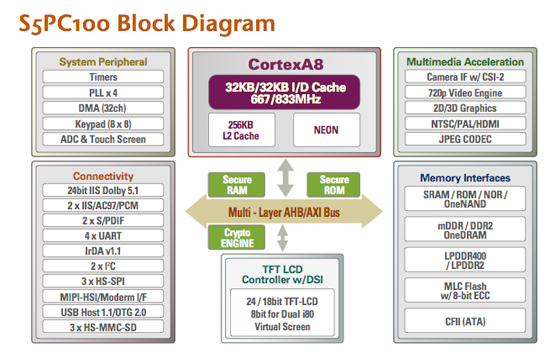Understanding the iPhone 3GS
by Anand Lal Shimpi on July 7, 2009 12:00 AM EST- Posted in
- Smartphones
- Mobile
Putting it in Perspective
Below is a table of the CPUs used in some of the top smartphones on the market, let’s put our newly refreshed knowledge to the test.
| CPU | Issue Width | Basic Pipeline | Clock Speed | |
| Apple iPhone/iPhone 3G | Samsung ARM11 | single | 8-stage | 412MHz |
| Apple iPhone 3GS | Samsung ARM Cortex A8 | dual | 13-stage | 600MHz |
| HTC Hero | Qualcomm ARM11 | single | 8-stage | 528MHz |
| Nokia N97 | ARM11 | single | 8-stage | 424MHz |
| Palm Pre | TI ARM Cortex A8 | dual | 13-stage | 600MHz |
| RIM Blackberry Storm | Marvell ARM11 | single | 8-stage | 624MHz |
| T-Mobile G1 | ARM11 | single | 8-stage | 528MHz |
The first thing you’ll notice is that there are a number of manufacturers of the same CPUs. Unlike the desktop x86 CPU market, there are a multitude of players in the ARM space. In fact, ARM doesn’t manufacture any processors - it simply designs them. The designs are then licensed to companies like Marvell, Samsung, Texas Instruments and Qualcomm. Each individual company takes the ARM core they’ve licensed and surrounds it with other processors (e.g. graphics cores from PowerVR) and delivers the entire solution as a single chip called a System on a Chip (SoC). You get a CPU, GPU, cellular modem and even memory all on a single chip, all with minimal design effort.

A derivative of this is what you'll find in the iPhone 3GS
While it takes ARM a few years to completely architect a new design, their licensees can avoid the painful duty of designing a new chip and just license the core directly from ARM. ARM doesn’t have to worry about manufacturing and its licensees don’t have to focus on building world class microprocessor design teams. It’s a win-win situation for this business.
For the most part, ARM’s licensees don’t modify the design much at all. There are a few exceptions (e.g. Qualcomm’s Snapdragon Cortex A8), but usually the only things that will differ between chips are clock speeds and cache sizes.
The fundamentals of the architectures don’t vary from SoC to SoC, what does change are the clock speeds. Manufacturers with larger batteries and handsets can opt for higher clock speeds, while others will want to ship at lower frequencies. The ARM11 based products all fall within the 400 - 528MHz range. These are all single-issue chips with an 8-stage pipeline.
| iPhone 3G (ARM11) | iPhone 3GS (ARM Cortex A8) | |
| Manufacturing Process | 90nm | 65nm |
| Architecture | In-Order | In-Order |
| Issue Width | 1-issue | 2-issue |
| Pipeline Depth | 8-stage | 13-stage |
| Clock Speed | 412MHz | 600MHz |
| L1 Cache Size | 16KB I-Cache + 16KB D-Cache | 32KB I-Cache + 32KB D-Cache |
| L2 Cache Size | N/A | 256KB |
The iPhone 3GS and the Palm Pre both ship with a Cortex A8. I’m actually guessing at the clock speeds here, there’s a chance that both of these devices run at closer to 500MHz but it’s tough to tell without querying the hardware at a lower level. The Cortex A8 gives us a deeper pipeline, and thus higher clock speeds, as well as a dual issue front end. The end result is significantly higher performance. Apple promised > 2x performance improvements from the iPhone 3GS over the iPhone 3G, such an increase was only possible with a brand new architecture.

I must stress this again: clock speed alone doesn’t determine the performance of a processor. Gizmodo’s recent N97 review complained about the speed of Nokia’s 424MHz processor (rightfully so). The review continued by saying that HTC uses 528MHz processors, implying that Nokia should do the same. The second part isn’t what Nokia should be doing on its $500+ smartphone, what is inexcusable is the fact that Nokia is not using ARM’s latest and greatest Cortex A8 on such an expensive phone. It’s the equivalent of Dell shipping a high end PC with a Core 2 Duo instead of a Core i7; after a certain price point, the i7 is just expected.










60 Comments
View All Comments
iwodo - Thursday, July 9, 2009 - link
Would really love Anand digg deeper and give us some more info. The info i could find for Atom, has 47 Million transistors. Ars report 40% of it is cache, while others report the core is 13.7 million. The previous iPhone article Jarred Walton commented that x86 decoder no longer matters because 1.5 - 2 million transistors inside a billions transistor CPU is negligible. However in Mobile space, 2M inside a 13.7M is nearly 15%. Not to mention other transistor used that is needed for this decoding.The space required for Atom is 25mm2 on a 45NM ( Including All Cache) . Cortex A8 require 9mm2 ( dont know how many cache ) on 65nm.
What is interesting is how Intel manage to squeeze the north bridge inside the Atom CPU ( more transistors ) while making the Die Smaller. ( i dont know if Intel slides were referring to the total package size or the die size itself ).
snookie - Thursday, July 9, 2009 - link
The Pre hardware, as in case, screen, keyboard is terrible. Cheap, plasticky and breaking left and right on people. If Palm survives long enough to get to Verizon etc Here's hoping they come out with better hardware soon. I've used Blackberries for year but I see no need for a physical keyboard. With the new iPhone widescreen keyboard I type with both thumbs very quickly and I have big hands.snookie - Thursday, July 9, 2009 - link
Jason, Apple has in fact agreed to using mini-usb as a standard. As if that is really a reason to buy a phone or not.To say Apple never changes shows no knowledge of the history of Apple, even their recent history.
Itaintrite - Wednesday, July 8, 2009 - link
Heh, it's funny how you say that you can't just look at clock speed, then followed with "the 528MHz processor in the iPod Touch is no where near as fast as the 600MHz processor in the iPhone 3GS." Heh.Anonymous Freak - Wednesday, July 8, 2009 - link
I want my punch and pie!Or a lollipop.
Good review, I could feel your hunger pangs toward both Palm and Apple toward the end...
monomer - Wednesday, July 8, 2009 - link
Regarding Anand's comments about Android phones needing an upgraded CPU, rumors are that the upcoming Sony Xperia Rachael will be sporting a 1GHz Qualcomm Snapdragon processor (ARM Cortex A8 derivative). Would love to find out the details of this phone when they become available.http://www.engadget.com/2009/07/04/sony-ericsson-r...">http://www.engadget.com/2009/07/04/sony...chael-an...
Affectionate-Bed-980 - Thursday, July 9, 2009 - link
Well I'd like to see Anand's experience with Android phones. What is it, just G1? Look at the new Hero or even G2. What about the Samsung i7500? Sorry I'm afraid that the limited nature of cell phone selection in the US makes it VERY HARD to review cell phones well here. I haven't seen a good cell phone site that's by people in the US and from the US only. Phone Arena, Mobile Burn, Phonescoop, GSM Arena, It seems the international guys get a LOT more exposure, and this is why I feel like Anand's comments about phones in general makes him sound inexperienced which I can certainly bet is the case.If you limit yourself to only carrier offered phones, then I don't think you can make accurate assessments about manufacturers like Nokia or certain OS phones like WinMo or Symbian or even Android unless the US starts offering more of what the world considers top notch popular phones.
Affectionate-Bed-980 - Wednesday, July 8, 2009 - link
N97 specs should be 434 MHz ARM11 not 424...Affectionate-Bed-980 - Wednesday, July 8, 2009 - link
BTW I don't believe you should be commenting about the N97. Gizmodo is heavily biased towards iPhones and unless you yourself Anand uses some Symbian S60 phones with detail, I don't really think you should join in the S60 bashing. I think a lot of us Symbian users AGREE that the platform needs to improve, but considering we were like ZOMG434MHZFAIL, the N97 is not bad in response time if you look at a few videos. The UI exceeded a lot of expectations amongst the Symbian crowd. If anything why don't you throw the Samsung i8910 Omnia HD in there instead? That has a Cortex A8 and uses Symbian S60v5 (not to mention has been out longer than the N97). The other S60v5 phone to come out is the Sony Satio which also uses a Cortex A8.You might as well comment on why Cortex A8 isn't being implemented in all new phones. WinMo phones are still on ARM11, and even HTC's newest announcements are ARMv7 chips. The iPhone doesn't define what high end is. Because if you want to point out that its unacceptable to have a ARMv7 chip in an N97, then it's just as unacceptable for the iPhone not to have a 5MP camera and multitasking.
straubs - Wednesday, July 8, 2009 - link
1. It IS unacceptable for any flagship phone to use ARM11. The iPhone, Pre, and Omnia HD (as you pointed out) all use it, so why wouldn't Nokia put it in it's $700 N-series flagship? It doesn't make sense. I'm surprised he didn't mention the crappy screen on the N97.2. He did comment on how the iPhone needs multi-tasking and how much he missed the Pre's implementation of it.
3. Doesn't everyone at this point agree that the number of megapixels in a phone camera is not a huge deal, considering the size of the sensor and optics? I would guess the N97 pictures are better than those from the the 3GS, but nothing like the jump from an ARM11 or A8.